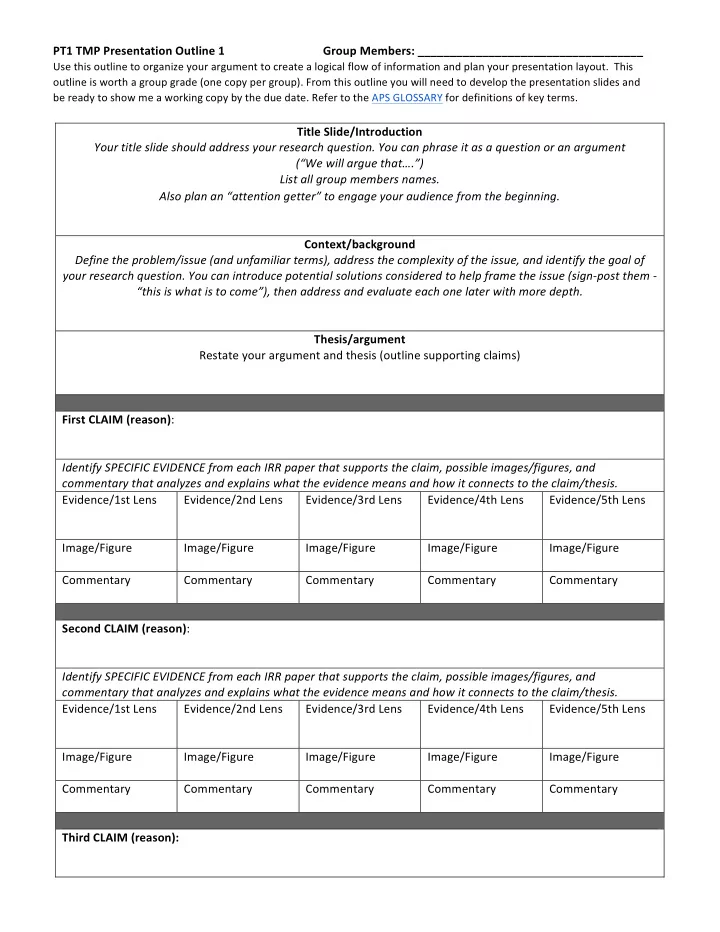

PT1 TMP Presentation Outline 1 Group Members: ___________________________________ Use this outline to organize your argument to create a logical flow of information and plan your presentation layout. This outline is worth a group grade (one copy per group). From this outline you will need to develop the presentation slides and be ready to show me a working copy by the due date. Refer to the APS GLOSSARY for definitions of key terms. Title Slide/Introduction Your title slide should address your research question. You can phrase it as a question or an argument (“We will argue that….”) List all group members names. Also plan an “attention getter” to engage your audience from the beginning. Context/background Define the problem/issue (and unfamiliar terms), address the complexity of the issue, and identify the goal of your research question. You can introduce potential solutions considered to help frame the issue (sign-post them - “this is what is to come”), then address and evaluate each one later with more depth. Thesis/argument Restate your argument and thesis (outline supporting claims) First CLAIM (reason) : Identify SPECIFIC EVIDENCE from each IRR paper that supports the claim, possible images/figures, and commentary that analyzes and explains what the evidence means and how it connects to the claim/thesis. Evidence/1st Lens Evidence/2nd Lens Evidence/3rd Lens Evidence/4th Lens Evidence/5th Lens Image/Figure Image/Figure Image/Figure Image/Figure Image/Figure Commentary Commentary Commentary Commentary Commentary Second CLAIM (reason) : Identify SPECIFIC EVIDENCE from each IRR paper that supports the claim, possible images/figures, and commentary that analyzes and explains what the evidence means and how it connects to the claim/thesis. Evidence/1st Lens Evidence/2nd Lens Evidence/3rd Lens Evidence/4th Lens Evidence/5th Lens Image/Figure Image/Figure Image/Figure Image/Figure Image/Figure Commentary Commentary Commentary Commentary Commentary Third CLAIM (reason):
Identify SPECIFIC EVIDENCE from each IRR paper that supports the claim, possible images/figures, and commentary that analyzes and explains what the evidence means and how it connects to the claim/thesis. Evidence/1st Lens Evidence/2nd Lens Evidence/3rd Lens Evidence/4th Lens Evidence/5th Lens Image/Figure Image/Figure Image/Figure Image/Figure Image/Figure Commentary Commentary Commentary Commentary Commentary Fourth CLAIM (reason): Identify SPECIFIC EVIDENCE from each IRR paper that supports the claim, possible images/figures, and commentary that analyzes and explains what the evidence means and how it connects to the claim/thesis. Evidence/1st Lens Evidence/2nd Lens Evidence/3rd Lens Evidence/4th Lens Evidence/5th Lens Image/Figure Image/Figure Image/Figure Image/Figure Image/Figure Commentary Commentary Commentary Commentary Commentary Limitations and Implications of chosen solution If not already addressed above, thoroughly explain the limitations and implications of your solution. ● IMPLICATION: A possible future effect or result ● LIMITATION: A boundary or point at which an argument or generalization is no longer valid. Address Counterarguments and Counterclaims Identify counterarguments or counterclaims and any evidence that conflicts with your argument or claims. Discuss the bias, weaknesses, or logical flaws in the counterclaims and/or the evidence. Rebut the counter (or refute/prove the evidence is wrong) and explain WHY their argument/claim/evidence is not as strong as yours. *** This section may need to be repeated for each counterclaim or conflicting evidence. You may also move it to a location within the presentation that is most effective (POINT-COUNTERPOINT strategy) *** Evaluate Alternative Solutions If not addressed already, evaluate the other potential (alternative) solutions, including their weaknesses due to their limitations, implications, and consequences. Explain and explicitly state WHY they are not as strong as your chosen argument/solution. *** This section may need to be repeated for each alternative solution you address. You may also move it to a location within the presentation that is most effective *** Conclusion The conclusion should seek to answer the research question (restate), restate your argument, and possibly suggest further future investigations, or other ways to approach the topic that would expand upon the research you’ve done and solution you have argued. Give the audience an opportunity to question their own position. References (APA) or Work Cited (MLA) Use parenthetical citation as needed throughout the PowerPoint for quotes and evidence. All images should also have a properly cited citation (under the picture, and then again on the work cited page). The References/Works Cited page should include all sources used in the presentation (not all sources will be used from each member’s
IRR. Include only those used in the presentation to support the argument and claims). Any additional sources you use (beyond the IRR) should also be properly cited and listed on your Reference page. See these resources for proper citation in presentations.
Recommend
More recommend